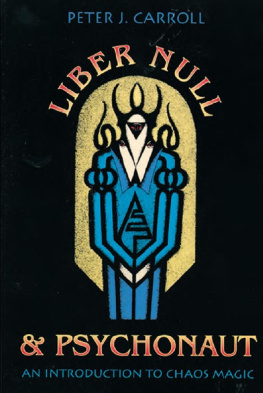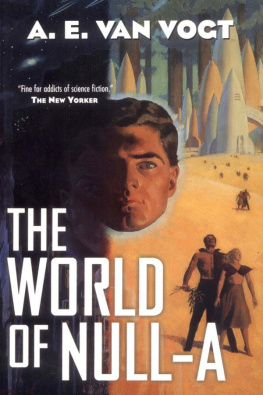Alfred Van Vogt - Null–A Three
Here you can read online Alfred Van Vogt - Null–A Three full text of the book (entire story) in english for free. Download pdf and epub, get meaning, cover and reviews about this ebook. genre: Science fiction. Description of the work, (preface) as well as reviews are available. Best literature library LitArk.com created for fans of good reading and offers a wide selection of genres:
Romance novel
Science fiction
Adventure
Detective
Science
History
Home and family
Prose
Art
Politics
Computer
Non-fiction
Religion
Business
Children
Humor
Choose a favorite category and find really read worthwhile books. Enjoy immersion in the world of imagination, feel the emotions of the characters or learn something new for yourself, make an fascinating discovery.
- Book:Null–A Three
- Author:
- Genre:
- Rating:3 / 5
- Favourites:Add to favourites
- Your mark:
- 60
- 1
- 2
- 3
- 4
- 5
Null–A Three: summary, description and annotation
We offer to read an annotation, description, summary or preface (depends on what the author of the book "Null–A Three" wrote himself). If you haven't found the necessary information about the book — write in the comments, we will try to find it.
Null–A Three — read online for free the complete book (whole text) full work
Below is the text of the book, divided by pages. System saving the place of the last page read, allows you to conveniently read the book "Null–A Three" online for free, without having to search again every time where you left off. Put a bookmark, and you can go to the page where you finished reading at any time.
Font size:
Interval:
Bookmark:
AUTHORS DEDICATION
To my dear wife, Lydia, an exceptionally beautiful woman, for asking methe questions that finally started me thinking about what a third Null-Anovel should be about.
For Jacques Sadoul, editor of Jai Lu, who several times urged me towrite a sequel.
To Fred Pohl who, when he was editor of Galaxy Magazine, was the firstperson to ask me to write a Null-A sequel.
To the late John W. Campbell, Jr., whoas editor of Astounding ScienceFiction (now called Analog)when he serialized The World ofNull-A, called it a once-in-a-decade classic.
For the late Jack Goodman, editor of Simon and Schuster, who printed arevised World in 1948the first post-WWII science-fiction novel putout in hard cover by a major publisher.
For Raymond Healy, who recommended World to Jack Goodman.
For Don Wollheim who, printed the first paperback edition of World in1953, and later printed Players under the title The Pawns of Null-A.
To Count Alfred Korzybski, the Polish born mathematician, who formulatedthe Concepts of General Semantics, on which the Null-A novels are based.Korzybskis major work, Science and Sanity, was first published in1933, with the sub-heading: An Introduction to Non-Aristotelian Systemsand to General Semantics. The count died in 1950.
Science and Sanity is obtainable from the following:
Institute of General Semantics 3029 Eastern Avenue Baltimore, Maryland21224
International Society for General Semantics Box 2469
San Francisco, Calif. 94126
(ISGS publishes a quarterly journal, Et Cetera)
Introduction
What does 10, 20, 30 or 40 years do to a readers recollection of anovel read during one of those distant times?
My first novel about General Semantics, The World of Null-A, wasoriginally published in Astounding Stories (now called Analog) in 1945as a three-part serial.
In those days, editors of magazines that published novels in serialform, either had a low opinion, or a correct opinion, of the ability ofthe majority of their readers to recall the early installments. And so,I, as author, was expected to provide a summary of the first part as apreliminary to Part Two, and summaries of both parts One and Two whenPart Three was published a month later.
In what follows I have combined the best parts of these originalmagazine summaries of the first two installments and then added asummary of Part Three.
In the year 2560 A.D., the semantic philosophy of Null-A dominated humanexistence. Annually, in the games of the Machine, hundreds of thousandsof young men and women competed during the policeless month and tried tobecome worthy of Venus. The lesser winners were awarded all the goodjobs on Earth. The top winners were sent to glorious Venus, there tobecome citizens in an all Null-A civilization.
Gilbert Gosseyn received his first shock on the eve of the first day ofthe Games. He was barred from the mutual protective group of the hotelin which he was stayingbecause a lie detector stated that he was notGilbert Gosseyn. The hotel security forces promptly expelled him fromhis room.
Out in the night he rescues a young woman from marauders of thepoliceless period. He quickly suspects that she is not, as she hasstated, a poor working girl, because she flashes a twenty-five thousanddollar bejewelled cigarette case. He begins to realize that he hasbecome involved in some tremendous intrigue when he discovers she isPatricia Hardie, daughter of Michael Hardie, President of Earth.
The Games Machine also tells him, when he arrives for his first test,that he is not Gilbert Gosseyn. But it informs him that he will beallowed to compete under the name of Gilbert Gosseyn for fifteen days,by which time he must have discovered who he really is.
That night Gosseyn is kidnapped, and taken to the palace-home ofPresident Hardie. He is interviewed by Hardie, by a cripple with astrong personality whose name is X, and by a sardonic giant namedThorson.
He learns that the President of Earth is involved in a plot to destroyNull-A, and seize control of the Solar System.
The three plotters become very excited when they discover something in aphotograph of Gosseyns brain. And, when after being driven almostinsane by torture, he succeeds in escaping from a steel-walled room, heis pursued and mowed down by machine gun bullets and flame guns. Thusdeath comes to Gilbert Gosseyn I.
Gosseyn awakens in a mountain hospital on Venus. He has the full memoryof having been killed, and he realizes that somehow, someway, hispersonality has been preserved in another body that looks exactly likethe first.
He swiftly discovers that he is illegally on Venus, and accordingly issubject to death, automatically. He overpowers John and Amelia Prescott,the doctors in charge of the hospital, half-convinces them of a plot tooverthrow Null-A, and then sets out into the Venusian wilderness toescape the detectives they had previously called to arrest him.
Venus turns out to be a fantastic land with trees three thousand feettall and hundreds of feet in diameter. It abounds with natural fruitsand vegetables, and the climate is perpetually, marvellously mild. It isa land of dreams, the heaven of the Solar System.
On the sixteenth day a roboplane agent of the Games Machine rescues him,informs him that there is no chance of his escaping capture, and adviseshim to surrender to the pursuing detectives with a carefully preparedstory. It tells him that fully half the detectives on Venus are agentsof the gang, and that it is taking him to a forest of one of thereliable detectives.
At the last minute, as he is getting out of the roboplane, it explainsthat there is a factor in the affair about which it knows nothing, analien factor. But that whatever evidence is available, he will find ithere.
Gosseyn finds the tree house furnished but unoccupied. He discovers acurious tunnel at the back of the apartment. The tunnel leads into thedepths of the tree, and, after some strange dreams about beings andships that have come from remote interstellar space, he decidesreluctantly to explore the tunnel.
But it turns out to be very long, intertwining through the roots of thecolossal trees, so he returns to the tree house for food. He is capturedand taken back to earth.
There he sees the body of Gosseyn I, and realizes that he is in asecond duplicate body. He is invited to join the gang, and he has justrefused when John Prescott, the Venusian, kills President Hardie and Xand drugs the other men in the room.
Gosseyn and Prescott escape, and Gosseyn seeks out a psychologist tofind out what it is in his brain that has made him the center of anintrigue, which actually held up the gangs plan to invade Venus.
The psychologist, Dr. Kair, examines his extra-brain, and for the firsttime he learns the difficulties that stand in the way of training thatpart of his mind. In the midst of the investigation, they discover thatPrescott is really an agent of the inner group of the gang; and that hekilled Hardie and X with the double purpose of convincing Gosseyn ofhis bona fides, and of using the hunt for the assassins as a means ofusing Earth against the Games Machine and Venus.
Kair and Gosseyn escape in a plane, after learning from Prescott thatthe Distorter is in the wall of Patricia Hardies bedroom. Kair plans totake Gosseyn to a lakeshore cabin which he owns, but after thepsychologist falls asleep, Gosseyn realizes there is no time to waste.
So he carefully turns the plane around, and jumps in an anti-gravityparachute down onto the palace balcony that leads into Patricia Hardiesapartment.
He is captured by Eldred Crang, Venusian detectiveand turned loose.After what Prescott overheard Kair discover about Gosseyns brain, theyno longer fear him. Indeed, the gang realizes they are expected to killGosseyn. They refuse.
Font size:
Interval:
Bookmark:
Similar books «Null–A Three»
Look at similar books to Null–A Three. We have selected literature similar in name and meaning in the hope of providing readers with more options to find new, interesting, not yet read works.
Discussion, reviews of the book Null–A Three and just readers' own opinions. Leave your comments, write what you think about the work, its meaning or the main characters. Specify what exactly you liked and what you didn't like, and why you think so.










